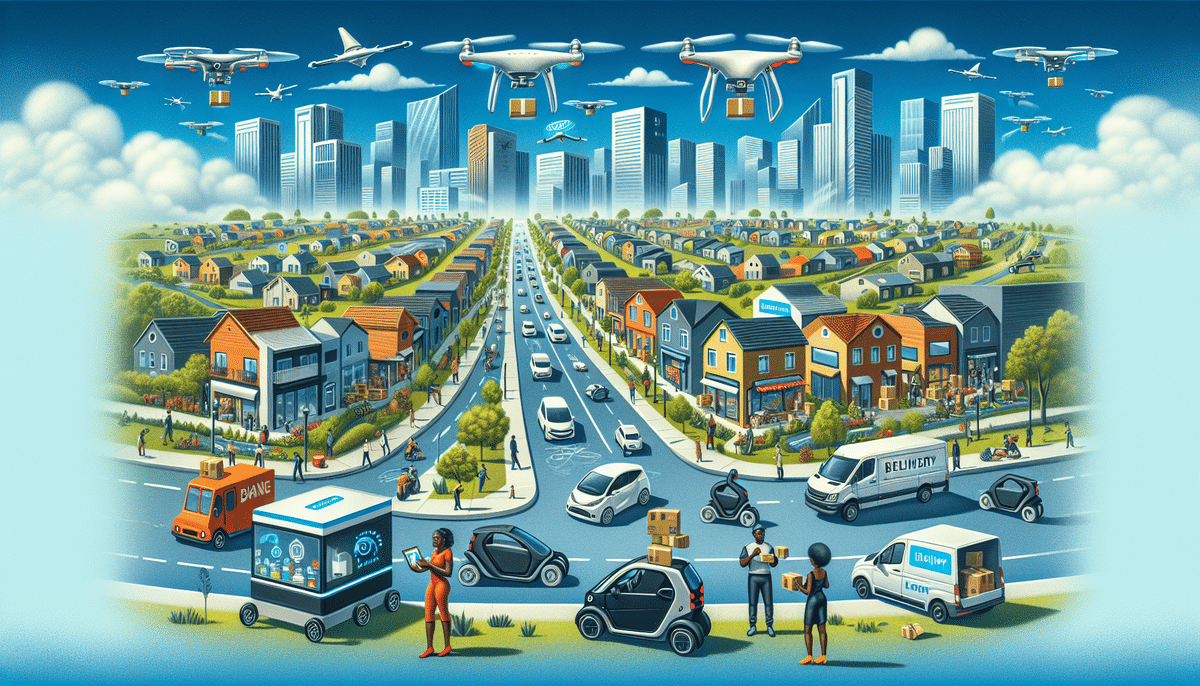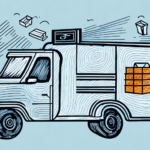In recent years, e-commerce has experienced a significant boom, and last-mile delivery is at the forefront of the resulting changes in logistics. When it comes to e-commerce, last-mile delivery is defined as the final stage of the process whereby goods arrive at their ultimate destination, which is the customer's doorstep. This aspect of logistics is critical since it determines overall customer satisfaction, which directly affects the success of e-commerce companies. Understanding the concept of last-mile delivery in e-commerce is crucial for businesses that want to remain competitive and provide high-quality service to their customers.
Understanding the Concept of Last-Mile Delivery in E-Commerce
Last-mile delivery is often seen as one of the most critical aspects of e-commerce logistics. It can make or break the customer experience, leading to either positive or negative reviews and brand sentiment. The primary objective of last-mile delivery is to deliver products to customers efficiently and at a reasonable cost while ensuring their satisfaction. To achieve this, companies must optimize the final steps of the delivery process, which includes precise scheduling, the use of effective and reliable transport methods, and reducing delivery times as much as possible.
One of the biggest challenges in last-mile delivery is the issue of delivery to remote or hard-to-reach areas. These regions often require specialized transport methods, such as drones or boats, which can be expensive and time-consuming. However, companies that can successfully navigate these challenges can gain a competitive advantage by reaching customers that other companies cannot. Additionally, businesses can explore alternative delivery options, such as click-and-collect or locker systems, which provide customers with more flexibility and convenience.
The Role of Technology in Enhancing Last-Mile Delivery Efficiency
Emerging technologies such as Artificial Intelligence (AI) and the Internet of Things (IoT) have transformed logistics in several ways. Today, technology plays a critical role in optimizing last-mile delivery. Innovations like truck routing optimization, GPS tracking, and predictive analytics enable companies to enhance their last-mile delivery performance significantly. According to a McKinsey report, AI algorithms are increasingly being developed to predict the likelihood of delivery issues, thereby improving contingency planning. By enhancing the efficiency of the last-mile delivery process, e-commerce companies can improve their bottom lines while meeting customer demand and satisfaction.
One of the most significant benefits of technology in last-mile delivery is the ability to provide real-time updates to customers. With GPS tracking and mobile apps, customers can track their deliveries in real-time, receiving notifications about the status of their package and estimated delivery times. This level of transparency and communication helps build trust between the customer and the company, leading to increased customer loyalty and satisfaction.
Another way technology is enhancing last-mile delivery efficiency is through the use of drones and autonomous vehicles. While still in the early stages of development, these technologies have the potential to revolutionize last-mile delivery by reducing delivery times and costs. Drones, in particular, can navigate through traffic and deliver packages directly to customers' doorsteps, eliminating the need for human drivers and reducing the risk of accidents on the road.
The Challenges of Last-Mile Delivery and How to Overcome Them
Common Challenges
- Traffic congestion
- Lack of skilled drivers
- Difficulty in finding customer delivery addresses
- High transportation and labor costs
Strategies to Overcome Challenges
- Offering flexible delivery schedules
- Utilizing third-party logistics (3PL) providers
- Optimizing delivery routes with advanced software
- Implementing smart lock-box delivery solutions
- Exploring subscription-based delivery services
The Evolution of Last-Mile Delivery in E-Commerce Logistics
As e-commerce continues to grow, the role of last-mile delivery is becoming even more critical. Historically, home delivery was reserved for select items such as luxury goods, representing a small proportion of online purchases. Today, items such as groceries and everyday household items are increasingly delivered via the last-mile process. Furthermore, consumers now expect faster delivery times, pushing e-commerce providers to offer same-day and even hour-long delivery services. According to a Business Insider report, same-day delivery options have grown by over 20% in the past year alone.
One of the biggest challenges facing last-mile delivery is sustainability. With the rise of e-commerce, there has been a corresponding increase in the number of delivery vehicles on the road, leading to concerns about air pollution and traffic congestion. To address this issue, many companies are exploring alternative delivery methods such as electric vehicles, drones, and even bicycle couriers.
Another trend in last-mile delivery is the use of data analytics to optimize delivery routes and improve efficiency. By analyzing data on factors such as traffic patterns, delivery volumes, and customer preferences, companies can make more informed decisions about resource allocation and streamline their operations. This can lead to faster delivery times, lower costs, and a better overall customer experience.
Analyzing Consumer Behavior and Its Impact on Last-Mile Delivery Strategies
Consumer behavior analysis is critical for businesses seeking to optimize their last-mile delivery strategies. Understanding consumer buying behavior, location, and preferences enables businesses to customize their last-mile delivery approaches. With this knowledge, companies can offer same-day delivery services or delivery during off-hours when customers are more likely to be available at their homes to accept the product.
Understanding the demographics and preferences of different regions, areas, or neighborhoods can also help companies distribute products more effectively and efficiently. For instance, urban areas might benefit from micro-warehousing and bike couriers, while rural areas may require partnerships with local businesses for delivery infrastructure.
Another important aspect of analyzing consumer behavior is identifying the most popular delivery methods. Some customers may prefer traditional delivery methods, while others may opt to pick up their orders at a nearby store. By understanding these preferences, businesses can offer a variety of delivery options to cater to different customer needs.
Furthermore, analyzing consumer behavior can help businesses identify potential issues in their last-mile delivery strategies. For example, if customers frequently report issues with late deliveries or damaged products, businesses can use this information to improve their delivery processes and ensure customer satisfaction. Continual analysis and adaptation based on consumer behavior allow businesses to stay ahead of the competition and provide exceptional last-mile delivery services.
Key Metrics for Measuring the Success of Last-Mile Delivery Operations
Essential Metrics
- Delivery Time: The average time taken to deliver a package from the warehouse to the customer.
- Delivery Success Rate: The percentage of deliveries completed without any issues.
- On-Time Delivery Percentage: The proportion of deliveries made on or before the promised time.
- Delivery Cost per Package: The average cost incurred to deliver a single package.
Customer Feedback
Another important metric is customer feedback. Gathering feedback about the delivery experience provides valuable insights into areas that need improvement. This includes feedback on delivery times, delivery personnel, packaging, and overall satisfaction with the delivery process. Incorporating customer feedback into performance metrics ensures that companies are meeting the needs and expectations of their customers.
The Impact of COVID-19 on Last-Mile Delivery Trends in E-Commerce
The COVID-19 pandemic significantly accelerated the growth of e-commerce, leading to an unprecedented surge in last-mile delivery services. With lockdowns and social distancing measures in place, online sales increased dramatically, resulting in new challenges for last-mile delivery, including ensuring safety through contactless delivery methods. According to a Forbes article, the demand for contactless delivery options became a standard expectation among consumers.
Another trend that emerged during the pandemic was the exploration of alternative delivery methods, such as drones and autonomous vehicles. These methods aim to reduce human contact and increase delivery efficiency. While still in the testing phase, they hold the potential to revolutionize last-mile delivery in the future. However, regulatory and safety concerns must be addressed before widespread adoption can occur.
Best Practices for Last-Mile Delivery Optimization
Operational Best Practices
- Route Optimization: Using advanced software to determine the most efficient delivery routes can significantly reduce delivery times and fuel costs.
- Local Partnerships: Building partnerships with local businesses to offer parcel delivery services can expand delivery options, especially in rural areas.
- Flexible Delivery Options: Providing customers with various delivery options, such as scheduled deliveries or pickup points, can minimize failed delivery attempts and associated costs.
Technological Enhancements
- Real-Time Tracking: Implementing systems that allow real-time tracking of deliveries helps in quickly identifying and resolving issues like traffic delays or incorrect addresses.
- Data Analytics: Leveraging data analytics to analyze delivery patterns and customer behavior can uncover areas for improvement and optimize delivery routes.
- Automated Delivery Vehicles: Investing in automated delivery vehicles can reduce labor costs and increase delivery efficiency.
Future Trends and Innovations in Last-Mile Delivery for E-Commerce
As the e-commerce industry continues to grow, the future of last-mile delivery holds several opportunities for innovation. Autonomous vehicles, delivery drones, and crowdsourced delivery models are expected to provide more efficient, cost-effective, and secure delivery channels. According to a Forbes Tech Council, these technologies will play a pivotal role in shaping the future of last-mile delivery.
Last-mile delivery providers will need to experiment and innovate to meet evolving customer demands, ensuring they stay ahead of the competition and meet customer expectations. Sustainability will also be a significant focus, with companies seeking eco-friendly delivery solutions to reduce their carbon footprint.
Conclusion
Last-mile delivery is a critical component of e-commerce, significantly impacting the overall customer experience. The challenges of last-mile delivery include traffic congestion, unpredictability, high costs, and time constraints. To maximize efficiency, businesses must adopt strategies such as implementing emerging technologies, optimizing delivery routes, and providing multiple delivery options. The future of last-mile delivery is poised for numerous trends and innovations, and companies must adapt to the evolving e-commerce landscape to maintain competitiveness and ensure customer satisfaction.




















